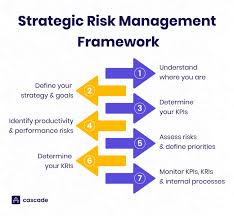

In today’s fast-paced and dynamic business environment, companies face a multitude of risks that can significantly impact their operations, profitability, and reputation. Managing these risks effectively requires a comprehensive understanding of legal strategies that can safeguard a business against potential threats. This article delves into the critical legal strategies for managing business risks, offering insights and actionable steps to help companies navigate the complexities of the modern business landscape.
Understanding Business Risks
Business risks come in various forms, including financial, operational, compliance, reputational, and strategic risks. Each type of risk can arise from different sources, such as market fluctuations, regulatory changes, technological advancements, and human factors. Identifying and assessing these risks is the first step in developing effective legal strategies to manage them.
The Role of Legal Strategies in Risk Management
Legal strategies play a pivotal role in managing business risks by providing a framework for identifying, assessing, and mitigating potential threats. These strategies encompass a wide range of activities, including contract management, regulatory compliance, intellectual property protection, and dispute resolution. By leveraging legal expertise, businesses can proactively address risks and minimize their impact on operations and profitability.
Key Legal Strategies for Managing Business Risks
- Contract Management
Contracts are the backbone of business transactions and relationships. Effective contract management involves drafting, reviewing, and negotiating contracts to ensure they accurately reflect the terms and conditions agreed upon by the parties involved. Key elements of contract management include:
- Clear and Specific Terms: Contracts should clearly outline the rights, obligations, and responsibilities of each party to prevent misunderstandings and disputes.
- Risk Allocation: Contracts should include clauses that allocate risks appropriately, such as indemnification, limitation of liability, and force majeure provisions.
- Compliance with Laws: Contracts must comply with relevant laws and regulations to ensure their enforceability and avoid legal pitfalls.
- Regular Review and Updates: Contracts should be reviewed and updated regularly to reflect changes in business operations, market conditions, and legal requirements.
2. Regulatory Compliance
Regulatory compliance is essential for managing business risks and avoiding legal penalties. Companies must stay informed about the laws and regulations governing their industry and ensure they adhere to them. Key aspects of regulatory compliance include:
- Compliance Programs: Developing and implementing comprehensive compliance programs to monitor and enforce adherence to legal requirements.
- Training and Education: Providing regular training and education to employees about compliance obligations and best practices.
- Audits and Assessments: Conducting regular audits and assessments to identify compliance gaps and address them proactively.
- Engagement with Regulators: Maintaining open communication with regulatory authorities to stay updated on changes in regulations and seek guidance when needed.
3. Intellectual Property Protection
Intellectual property (IP) is a valuable asset for many businesses, and protecting it is crucial for managing risks related to innovation and competition. Key strategies for IP protection include:
- Registration and Enforcement: Registering patents, trademarks, copyrights, and trade secrets to establish legal rights and prevent unauthorized use.
- IP Audits: Conducting regular IP audits to identify and assess IP assets, ensuring they are adequately protected and utilized.
- Confidentiality Agreements: Using confidentiality agreements (NDAs) to safeguard sensitive information and prevent its unauthorized disclosure.
- Monitoring and Enforcement: Actively monitoring the market for potential IP infringements and taking prompt legal action to enforce IP rights.
4. Dispute Resolution
Disputes are an inevitable part of business operations, and having effective dispute resolution mechanisms in place is essential for managing risks. Key strategies for dispute resolution include:
- Alternative Dispute Resolution (ADR): Utilizing ADR methods such as mediation and arbitration to resolve disputes amicably and cost-effectively.
- Litigation Management: Developing a robust litigation management strategy to handle legal disputes efficiently and minimize their impact on business operations.
- Settlement Negotiations: Engaging in settlement negotiations to resolve disputes without resorting to costly and time-consuming litigation.
- Dispute Prevention: Implementing proactive measures to prevent disputes, such as clear communication, thorough documentation, and compliance with contractual obligations.
5. Risk Assessment and Management
Effective risk management requires a systematic approach to identifying, assessing, and mitigating risks. Key components of risk assessment and management include:
- Risk Identification: Identifying potential risks through various methods, such as risk assessments, audits, and scenario analysis.
- Risk Assessment: Evaluating the likelihood and impact of identified risks to prioritize them and allocate resources accordingly.
- Risk Mitigation: Implementing measures to mitigate risks, such as developing contingency plans, purchasing insurance, and enhancing security protocols.
- Continuous Monitoring: Continuously monitoring and reassessing risks to ensure that risk management strategies remain effective and relevant.
Integrating Legal Strategies into Business Operations
Integrating legal strategies into business operations requires a proactive and collaborative approach. Companies should foster a culture of risk awareness and legal compliance across all levels of the organization. Key steps to achieve this include:
- Leadership Commitment: Securing commitment from top management to prioritize risk management and legal compliance.
- Cross-Functional Collaboration: Encouraging collaboration between legal, compliance, finance, and operational teams to address risks holistically.
- Resource Allocation: Allocating adequate resources, including budget and personnel, to support risk management and legal compliance efforts.
- Technology Utilization: Leveraging technology, such as risk management software and compliance tools, to enhance the efficiency and effectiveness of legal strategies.
The Future of Legal Strategies for Managing Business Risks
As the business landscape continues to evolve, so too will the risks that companies face. Emerging trends and technologies, such as artificial intelligence, blockchain, and data analytics, present new opportunities and challenges for risk management. Key trends shaping the future of legal strategies for managing business risks include:
- Data Privacy and Cybersecurity: With the increasing reliance on digital technologies, data privacy and cybersecurity have become critical concerns for businesses. Companies must stay ahead of evolving regulations and implement robust security measures to protect sensitive information.
- Environmental, Social, and Governance (ESG) Risks: ESG factors are gaining prominence, and companies are increasingly being held accountable for their environmental and social impact. Legal strategies must address ESG risks and ensure compliance with related regulations and standards.
- Globalization and Cross-Border Risks: Globalization has expanded the scope of business operations, exposing companies to cross-border risks such as regulatory differences, geopolitical tensions, and international trade disputes. Legal strategies must navigate these complexities to manage global risks effectively.
- Technological Advancements: Rapid technological advancements are transforming industries and creating new legal challenges. Companies must stay abreast of technological developments and adapt their legal strategies to address associated risks, such as intellectual property issues and regulatory compliance.
Conclusion
Effective management of business risks is essential for the long-term success and sustainability of any organization. By implementing comprehensive legal strategies, companies can proactively address potential threats and safeguard their operations, profitability, and reputation. The key legal strategies for managing business risks include contract management, regulatory compliance, intellectual property protection, dispute resolution, and risk assessment and management. Integrating these strategies into business operations requires a proactive and collaborative approach, with a focus on leadership commitment, cross-functional collaboration, resource allocation, and technology utilization. As the business landscape continues to evolve, companies must stay ahead of emerging trends and challenges to effectively manage risks and achieve sustainable growth.
· Legal risk management strategies
· Business risk assessment
· Contract management strategies
· Regulatory compliance
· Intellectual property protection
· Dispute resolution methods
· Risk mitigation legal strategies
· Compliance programs for businesses
· Managing business legal risks
· Alternative dispute resolution (ADR)
· Legal compliance tools
· Corporate governance and risk management
Contact Us
Chaman Law Firm today. Our offices are conveniently located in Lagos, FCT Abuja, Ogun State, and the UK. We are readily available to assist you with your legal needs. Whether you require consultation, representation, or ongoing legal support, Chaman Law Firm is your trusted partner.
Call us at 08065553671 or email us at info@chamanlawfirm.com to schedule a consultation.

